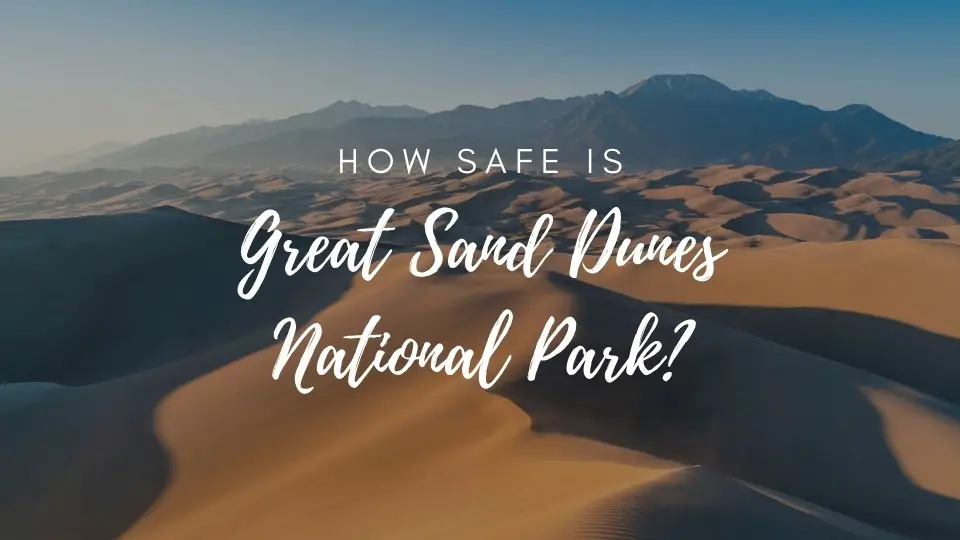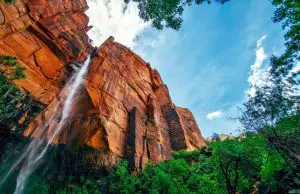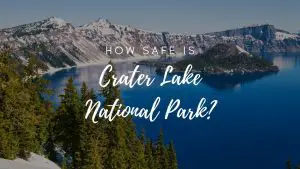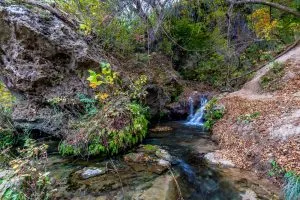Is Great Sand Dunes National Park Safe? (2023)

Great Sand Dunes National Park is located in southern Colorado and is known for its large sandy dunes. The dunes are formed by wind-blowing sand from the nearby mountains. The dunes are constantly changing and can be as high as 750 feet.
Is Great Sand Dunes National Park Safe? Yes, Great Sand Dunes National Park is safe. There are some risks associated with hiking and camping in the park, but these can be minimized by following some simple safety precautions. We will address the concerns and safety risks of Great Sand Dunes National Park in this article.
Quick Links
What Are The Biggest Dangers At Great Sand Dunes National Park?
Great Sand Dunes National Park is a beautiful and unique place, but it also has some dangers that visitors should be aware of.
One of the biggest dangers at Great Sand Dunes National Park is the terrain. The sand dunes are constantly shifting, and there are often hidden drop-offs and steep slopes. It’s important to stay on marked trails and to avoid hiking alone.
Another danger at Great Sand Dunes National Park is the weather. The park is located in a high-altitude desert, and the weather can change very quickly. Visitors should be prepared for extreme heat in the summer and cold and snow in the winter.
Finally, there are also dangers posed by the wildlife at Great Sand Dunes National Park. The park is home to many predators, including bears, mountain lions, and snakes. It’s important to be aware of your surroundings and to avoid hiking alone.
In the following sections, we’ll go over all of these dangers in more detail so that you can stay safe on your visit to Great Sand Dunes National Park.
Is Great Sand Dunes National Park Safe At Night?
Hiking and spending time in parks at night can be dangerous if you’re not aware of the potential hazards. Low visibility, more wildlife out at night, and uneven terrain are just a few of the dangers you might encounter. However, with some basic safety precautions, you can minimize the risks and have a great time exploring Great Sand Dunes National Park at night.
Here are some specific night-time dangers to be aware of when exploring Great Sand Dunes National Park:
- Flash floods are a common danger in the park. Be sure to check the weather forecast before heading out, and avoid hiking in canyons or washes.
- It can be very cold at night, even in the summer. Be prepared with warm clothing and shelter.
- There are no lights in the park, so bring a flashlight and be aware of your surroundings.
- Wildlife is more active at night. Be sure to make noise and carry a bear horn or hornet spray to deter predators.
Is It Safe To Go Alone To Great Sand Dunes National Park?
Hiking is a great way to get some exercise and fresh air, and it can be a very peaceful and calming experience. However, it’s important to be aware of the risks of hiking alone and to take precautions to ensure your safety.
There are several things to consider when deciding whether or not to hike alone. First, think about the terrain. If you’re not familiar with the area or if the terrain is particularly challenging, it’s best to hike with someone who knows the area well. Second, consider the wildlife. If you’re hiking in an area where there are predators, it’s best to hike with a group. Finally, think about the time of day. If you’re hiking in the dark or in an isolated area, it’s best to hike with a friend.
Here are some tips to help you stay safe while hiking alone:
- Let someone know where you’re going and when you expect to be back.
- Stay on well-traveled trails.
- Carry a whistle, and be prepared to use it if you need to.
- Pay attention to your surroundings, and be aware of potential hazards.
- Trust your gut. If something doesn’t feel right, turn back.
Is It Safe To Drink Water In Great Sand Dunes National Park?
There are a few risks to drinking untreated water in the wild, but generally, it is safe to do so. The biggest risk is contracting a gastrointestinal illness, which can be avoided by purifying your water first. There are a few different ways to purify water, including boiling, filtering, and using iodine tablets.
It is always best to purify your water before drinking it, even if you’re just hiking in the Great Sand Dunes National Park. There are a few different ways to purify water, including boiling, filtering, and using iodine tablets. Boiling is the most effective way to purify water, but it can be time-consuming. Filtering is a good second choice, and many different types of filters are available. Iodine tablets are the least effective method, but they are lightweight and easy to use.
The Wildlife Of Great Sand Dunes National Park
Great Sand Dunes National Park is home to a wide variety of wildlife. You may encounter animals such as coyotes, elk, deer, bighorn sheep, and pronghorn. The park is also home to a variety of birds, including eagles, hawks, and owls. While most of the wildlife in the park is harmless, there are some animals that can pose a threat.
If you encounter a coyote, do not approach it. If you see a coyote while hiking, make yourself as big as possible and make loud noises. You can also carry a walking stick or hiking poles to help deter coyotes. If a coyote does attack, fight back with whatever you have.
Elk, deer, bighorn sheep, and pronghorns are all generally harmless, but they can become aggressive during mating season. If you see any of these, do not approach them. Give the animal plenty of space, and do not make any sudden movements.
Hiking Safety Tips For Great Sand Dunes National Park
The Great Sand Dunes National Park is a beautiful and popular hiking destination. With so many people enjoying the park, it’s important to be aware of some safety tips to help everyone have a great time.
Here are some hiking safety tips for the Great Sand Dunes National Park:
- Stay on the trails: There are plenty of well-marked trails throughout the park. Staying on the trails helps to avoid getting lost and also helps to protect the delicate vegetation.
- Be aware of weather conditions: The weather can change quickly in the mountains, and it’s important to be prepared. Check the forecast before your hike, and be sure to bring appropriate clothing and supplies.
- Be aware of wildlife: The park is home to many different types of wildlife. Some of the animals, like bighorn sheep, are very friendly, but others, like bears, can be dangerous. Be sure to read the park’s wildlife safety tips before you hike.
Conclusion
In Conclusion, Great Sand Dunes National Park is safe for hikers and outdoor lovers. However, there are a few precautions to take. There are many different trails to explore in the park, and each one offers a different view of the unique landscape. The best way to stay safe while hiking in the park is to be aware of your surroundings and to follow the marked trails. Great Sand Dunes National Park is a beautiful place to explore, and by following these simple safety guidelines, you can ensure that your visit is a safe and enjoyable one.






